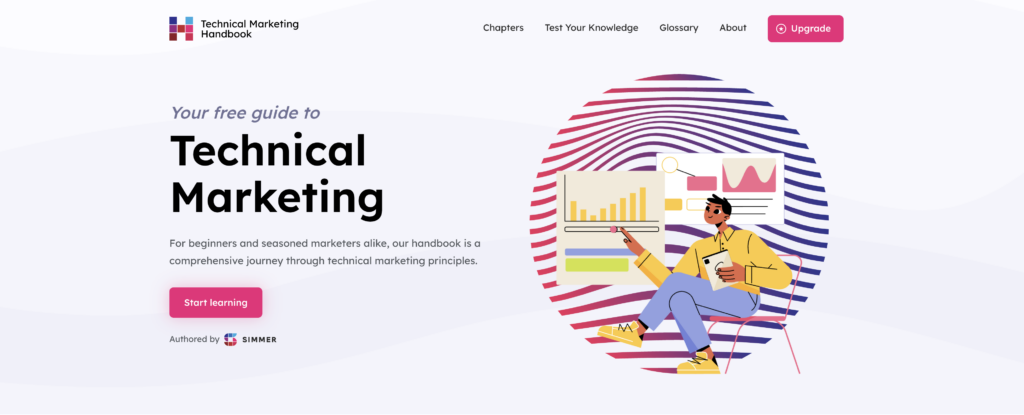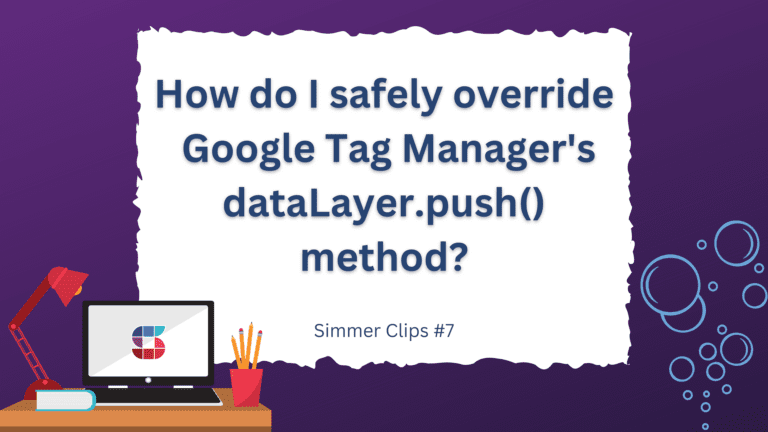Recently, we conducted a series of Q&A sessions on Simmer’s social media channels, and we received a great question from Leticia:
“What is the most effective starting point for someone with little to no technical marketing knowledge who aims to specialize in data analytics having at the same time technical marketing knowledge? The goal is to know 100% the fundamentals of tagging implementation, event and parameter setup, and report creation, with a thorough understanding of backend requirements.”
Leticia’s question inspired me to write this blog post – I wanted to make essential information readily available for anyone eager to begin their journey in the field of technical marketing.
Speaking from experience, I understand the challenge of navigating a new field. The web is packed with tips and tricks, but how do you figure out what is essential to you and your career development?
Technical marketing in itself includes various domains that demand expertise. Among these are SEO, CRO, data and analytics, tagging and tracking, web development, and digital advertising, for example. Each of these domains is quite vast, and mastering all of them requires a lot of time and effort.
Technical marketers usually have a T-shaped learning profile, meaning that they have deep knowledge of a few specific areas (the vertical bar of the “T”) and superficial knowledge about other topics within their field (the horizontal bar of the “T”).
Rather than attempting to become proficient in all areas, it is more practical and efficient to specialize in one. In Leticia’s case, specializing in data analytics would be a good strategic starting point. From there it is easier to find your niche, giving you a competitive advantage in the job market.
Data Analytics and Beyond
If you are interested in getting started with data analytics, you need to learn to use a tool that collects and processes data (such as Adobe Analytics, Amplitude, Google Analytics, and Piwik Pro), and ideally a tool that helps you visualize the data (such as Looker Studio and Power BI).
You won’t always be required to work with both approaches – implementation and visualization. Choose one that you want to focus on more deeply and make it your niche. If you choose the implementation side, dive deeper into tagging with tools like Google Tag Manager, and web technologies such as HTML and JavaScript. If you want to focus on visualization, learn some SQL and how to work with data warehouses like BigQuery. From visualization, it’s a short leap into actual “analytics”, where you can focus on advanced segmentation, data blending, and data activation.
Once you have a good grasp of data analytics, you can expand your knowledge into other areas of technical marketing to gain a comprehensive understanding of key concepts and terminology.
If you’re interested in data analytics, then branching out to web technologies (JavaScript, HTML, CSS) as well as data mining (SQL, Python, R) can take you far, depending on your specialization focus. While Leticia mentions “backend knowledge”, frontend knowledge is just as important for technical marketers.
Technical Marketing Handbook
Our forthcoming Technical Marketing Handbook introduces you to the diverse landscape of technical marketing. It will familiarize you with essential terminology and concepts across the field. I strongly recommend leveraging this resource as you embark on your technical marketing journey. You can then delve deeper into specific areas of interest with courses and other online resources.
The Technical Marketing Handbook will be launched during the last week of February 2024. It is completely free and you’ll be able to download a Certificate of completion once you have finished reading all the material in the Handbook. You will be able to access the Handbook through Simmer’s website.

In the meanwhile, there are plenty of insightful online courses available on data analytics, as well as online resources covering tagging implementation and other aspects of data implementation.
Consider exploring these resources to help you get started on your studies:




6 Responses
Hi Simmer Team,
I loved the Technical Marketer course – I learned a lot!
Much love from Poland
Michal
Thank you! We are so happy to hear you liked it 🙂
Hello Mari
Many thanks for this blog, it’s so interesting. 🙂
Hello! 👋 Thank you, I am glad to hear that! ☺️
Hello Mari!
Thank you for the article tips. I used to think that to be a T-shaped professional, I needed deep knowledge in all areas within the vertical bar (such as Privacy, Data Engineering, QA, Dashboarding, SQL, etc.). However, the article suggests (if I understood correctly) that a T-shaped professional should specialize in one or two areas (at least at the beginning) within the vertical bar. Is that right?
Or we start with 1 or 2 and then expand, right?
I’m trying to clarify whether a T-shaped professional is expected to have deep knowledge in all vertical bar fields or just one or two. I understand that this isn’t a strict rule, but maybe a process. After all, no one knows everything!
Thanks again for your insights, and sorry for dwelling on the topic! 😄
Hi João,
Thank you for your comment and the clarifying question – I am happy to clarify. ☺️
You understood my thoughts correctly. I suggest that a T-shaped professional knows a little about the main topics (represented by the horizontal line) but has deeper knowledge and experience in only 1-2 areas. And yes, we do expand as we keep learning and doing more. ✨